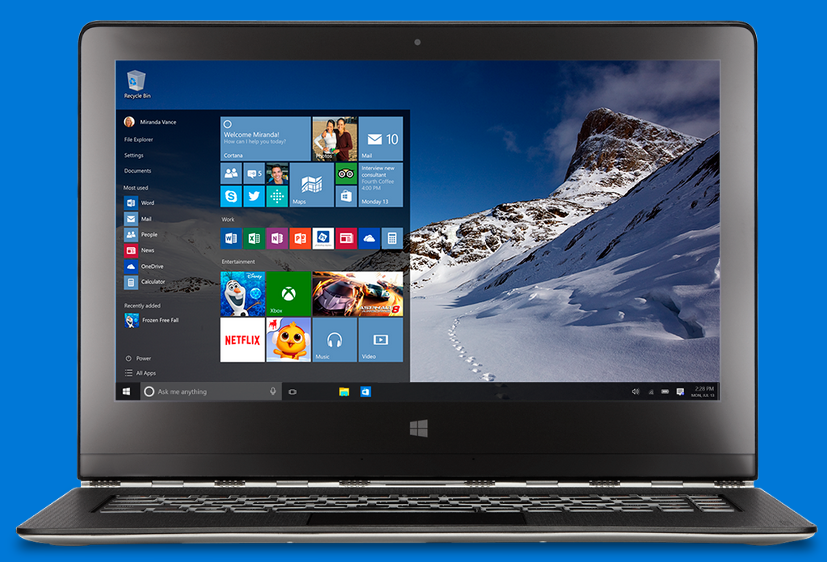
I was never a fan of Microsoft’s Windows 8, but so far I like what I’m seeing in Windows 10. I’ve been using the new operating system — which becomes available to some customers on Wednesday — on a Microsoft Surface 3 combination tablet and laptop but, even though the computer has a touch-screen, I’m mostly using the keyboard and touchpad to issue commands. I never have gotten used to issuing commands by touching the screen. I do that with my phone and my tablet, but when I’m using a PC I find that it’s a lot faster to use the keyboard and traditional pointing device. Besides, my desktop computer doesn’t even have a touch screen.
But, with Windows 10, Microsoft gives users a real choice. Those that are familiar with the Windows 8 touch interface will find it reasonably familiar, but so will those who are familiar with Windows 7 or earlier versions such as Windows XP.
And I think most PC users will be happy with some of the other new features in Windows 10 such as Cortana, the voice-controlled (Siri-like) virtual assistant and Microsoft Edge, the new browser that is replacing the aging Microsoft Internet Explorer.
While the new features are laudable, the big deal is that Microsoft is going back to the future by restoring the Start menu that Windows users had become accustomed to.
The new Start menu is a bit of a hybrid between the one in Windows 7 and the more graphically intense tiled interface of Windows 8. When you click on the Start icon — still in the lower left corner of the screen — it brings up a list of programs and commands, just as it did with Windows 7. But there are also tiles, or icons, for the apps that you use most often and you can resize each icon individually. If you’re a frequent Microsoft Word user, for example, you might want the Word icon to be very large but if you only occasionally need the calculator, you could make that one very small.
Or you could ignore the icons all together and simply type the name of the program you want to run or even use Cortana to launch it by voice. To launch Microsoft Word, for example, I said “Hey Cortana, launch Word” and, a few seconds later, Word was running. Cortana is also able to issue reminders. You can say “remind me to get milk tomorrow morning,” for example. Microsoft says that it can also be location aware such as “remind me to buy milk when I’m near Safeway” but that would only work if you’re using Windows 10 on a phone or tablet that you have with you while you’re driving around.
On Android and iOS phones, I’ve become very comfortable with issuing voice commands. I almost never dial my phone with my fingers but use voice instead and I use Google’s voice commands in the car to program Google maps. Sure, typing on a desktop is a lot easier than on a phone (especially when driving when it’s illegal and dangerous to touch your phone) but there is still something nice about being able to issue voice commands. For one thing, you don’t have to think about where the icon is located. If you can say the name of a program, you can run it — regardless of whether you can see its icon.
The Edge browser was code named “Project Spartan” because it’s faster and cleaner than the old Internet Explorer but, for those who want it, Internet Explorer is still there and there’s even an option in Edge to open a page in Internet Explorer. One cool Edge feature lets you annotate web pages with notes and then share them with others. There’s also a “reedling list” feature that allows you to save pages to read later — perhaps on a Windows phone or tablet if you have one.
The new browser works just fine but one of the nice thing about Windows 10 is that it also supports software written for earlier versions of Windows which means that Google Chrome, Firefox and other browsers still work. So, while I’m testing Edge on Windows 10, I’m actually using Google Chrome for my real work because I’m familiar with it, it works on both PCs and Macs and I’ve already configured all my shortcuts and extensions which Google stores in the cloud and automatically updates when you install it on a new machine.
In a departure from its past, Microsoft is offering Windows 10 as a free upgrade to those with Windows 7 or higher. If that’s you, there may be a new icon on your desktop that enables you to reserve your copy. Although Windows 10 does feel ready for prime time, as with any new operating system you may want to wait a few weeks before installing Windows 10 unless, like me, you’re comfortable being on the “bleeding edge” of technology.